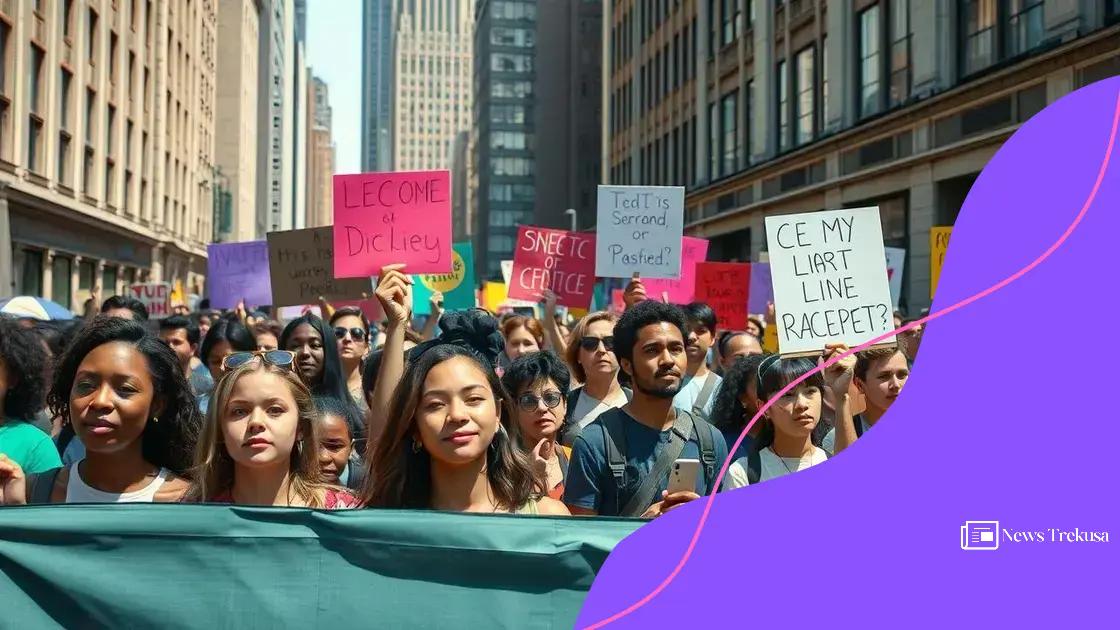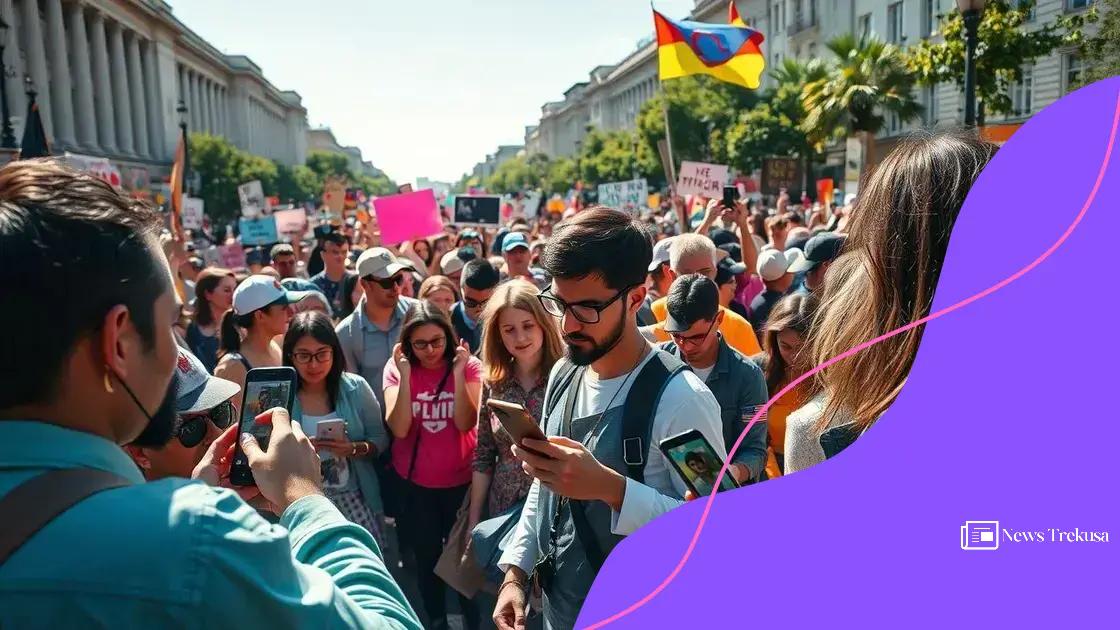National protest movements: understanding their impact

National protest movements are dynamic responses shaped by factors such as technology, political changes, and diverse activism, significantly impacting social issues and public policy.
National protest movements have shaped society in profound ways, sometimes altering the course of history. Have you ever wondered how these movements gain momentum and achieve their goals? Let’s dive deeper into this fascinating topic.
The historical context of national protest movements
The historical context of national protest movements is essential to understanding their evolution and impact. Over the years, various movements have emerged, driven by social, political, and economic factors. These movements often challenge the status quo and advocate for change based on the desires of the people.
Key Historical Movements
Some pivotal movements in history have laid the groundwork for contemporary protests. For instance, the Civil Rights Movement in the United States sought to end racial segregation and discrimination. Similarly, anti-war protests during the Vietnam War highlighted the public’s dissent against government policies.
Factors Leading to Protests
- Social Inequality: Disparities in wealth and privilege foster resentment among marginalized groups.
- Political Oppression: Authoritarian regimes often trigger uprisings as citizens press for democracy.
- Economic Hardship: High unemployment rates can spur protests as people demand better working conditions.
Throughout history, protests have acted as a catalyst for change. For example, the Arab Spring was a series of protests that resonated across North Africa and the Middle East, leading to significant political upheaval. Each movement carries its narratives, driven by the struggle of its people against various challenges.
As movements continue to evolve, they reflect the values and concerns of different generations. Today, environmental issues, social justice, and systemic racism are at the forefront of many protests. Understanding the historical context helps us see why these issues resonate so deeply with society.
Key players in modern protests
Understanding the key players in modern protests is crucial to grasp the dynamics of social movements today. Various individuals and groups play significant roles in organizing and promoting these protests. From activists to global organizations, each contributes uniquely to the cause.
Influential Activists
Many modern protests are led by passionate individuals who rally communities. These activists often have a personal connection to the causes they champion, making their missions authentic and relatable. They utilize social media platforms to spread awareness and mobilize supporters.
Grassroots Organizations
- Community Groups: Local organizations often focus on specific issues like housing or environmental concerns.
- National Networks: Larger coalitions connect community groups, amplifying their voices nationwide.
- Youth Movements: Young people increasingly lead the charge, using innovative tactics to attract attention and engagement.
In addition to activists and organizations, the impact of social media cannot be overstated. Platforms like Twitter and Facebook facilitate rapid information sharing and community building. They enable real-time updates and forge connections among diverse participants. As a result, the collective voice of protesters resonates louder, making it harder for authorities to ignore their demands.
Furthermore, celebrities and public figures often lend their support, drawing attention to the cause. Their involvement can significantly increase visibility and legitimacy for the movements. Their platforms serve as a megaphone, reaching audiences beyond traditional media channels.
Analyzing the impact of social media on movements

Analyzing the impact of social media on movements reveals how these platforms have transformed activism. Social media has changed how people communicate, organize, and mobilize for change. Today, information spreads rapidly, reaching a global audience almost instantly.
Speed and Reach
One major advantage of social media is its speed. News about protests can go viral within minutes, drawing attention from people worldwide. This rapid dissemination allows movements to gather support quickly. Hashtags and trending topics also contribute to spreading awareness.
Building Communities
- Support Networks: Social media helps form online communities, where individuals share experiences and resources.
- Grassroots Organizing: Local groups can connect with each other, forming a larger network for advocacy.
- Engaging a Youth Audience: Younger generations often prefer digital platforms, making social media a key tool in reaching them.
The ability to connect with like-minded individuals fosters a sense of belonging within movements. This connection can motivate people to participate in protests and events, enhancing overall engagement. Furthermore, social media allows for diverse voices to be heard, amplifying the message of the movement.
However, the impact of social media is not always positive. Misinformation can spread just as quickly as accurate information, leading to confusion and division. Additionally, the over-saturation of content can desensitize audiences, making it harder for crucial issues to stand out. Yet, despite these challenges, the overall effect of social media on movements has created powerful tools for activism.
Challenges faced by protest organizers
Protest organizers face numerous challenges that can impact the effectiveness of their movements. These obstacles can arise from various sources, including government actions, public opinion, and internal dynamics within the organizing group. Understanding these challenges is crucial for anyone involved in activism.
Government Response
One of the most significant hurdles is the response from the government. Authorities may impose restrictions on gatherings, apply pressure through legal means, or even use force to disperse protests. Such actions can create an atmosphere of fear that discourages participation.
Internal Coordination
- Communication Issues: Effective communication is vital for keeping all participants updated and engaged.
- Diverse Perspectives: Different viewpoints within the group can lead to conflicts, making it hard to maintain a unified message.
- Resource Management: Organizers often struggle with limited resources, from funding to volunteers, complicating logistics.
In addition to external pressures, organizers must navigate various logistical challenges. These include securing permits, coordinating transportation, and ensuring the safety of participants. Organizers often have to balance between maintaining the message of the protest and addressing practical concerns. This can be demanding, especially when faced with unexpected incidents.
Another challenge is the risk of burnout among organizers. The emotional and physical demands of planning and participating in protests can lead to fatigue. This fatigue can affect decision-making and overall effectiveness, highlighting the need for sustainable practices within organizing groups.
Future of national protest movements
The future of national protest movements is likely to be shaped by technological advancements, social changes, and evolving political landscapes. As society continues to face various challenges, protests will adapt to new realities and methods of communication.
Technology and Activism
Technology plays a crucial role in modern activism. Social media platforms will continue to serve as vital tools for organizing, informing, and mobilizing supporters. The rise of new technologies, such as blockchain and virtual reality, may also influence how protests are organized and experienced.
Political Landscape
- Legislative Changes: Governments might respond to protests with new laws, impacting how movements operate.
- Global Solidarity: Issues like climate change may unite movements across borders, creating a more interconnected approach.
- Increased Surveillance: Heightened security measures could make organizing more challenging yet may also spur innovative strategies.
As social issues evolve, the themes of protests will also change. New generations bring fresh perspectives on topics like climate action, social justice, and human rights. These movements will likely reflect the values and priorities of younger activists, who prioritize sustainability and inclusivity.
Furthermore, the ongoing globalization of information allows protests to gain attention beyond their local context. This international visibility can strengthen movements but may also lead to backlash from those in power. Still, the resilience of protesters and their adaptability will play a major role in shaping the effectiveness of future movements.
FAQ – Questions about National Protest Movements
What role does technology play in modern protest movements?
Technology, especially social media, allows activists to organize quickly, share information widely, and connect with like-minded individuals globally.
How do political changes affect protest movements?
Political changes can lead to new laws that may restrict protests or, conversely, create opportunities for change, influencing how movements are organized.
Why are youth important in today’s protests?
Younger activists bring fresh perspectives and energy, often focusing on urgent issues like climate change and social equality.
What challenges do organizers face during protests?
Organizers face various challenges, including government restrictions, internal coordination issues, and resource limitations that can impact the success of movements.
